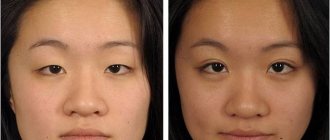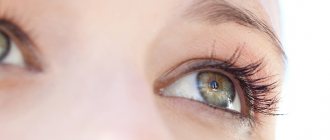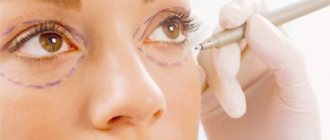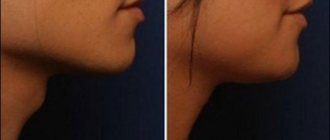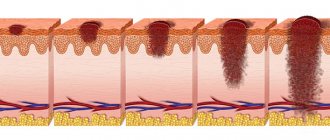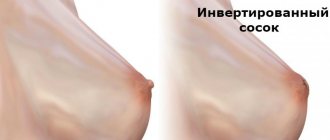Fat-saving blepharoplasty - the essence of the method
Perhaps the most advanced method in age-related eyelid correction today is fat-sparing blepharoplasty. The method is based on the uniform redistribution of fat pads surrounding the human eyeball on all sides.
Unlike the classical method of blepharoplasty, in this case all kinds of fatty hernias are not excised. Thus, a sufficient amount of tissue is preserved between the eyelid and the eyeball, which prevents the so-called skeletonization of the eyelid - the skin tightly fitting the eye socket.
By evenly distributing the patient’s own fat while filling the periorbital area, the surgeon thus prevents the eye from sinking, becoming more “recessed” into the orbit, and significantly evens out the nasolacrimal groove, which significantly rejuvenates the client’s appearance.
With fat-sparing blepharoplasty, after redistribution of intraorbital fat, excess skin on the eyelids is removed.
The effect after surgery is very lasting. The first signs of age-related changes will not make themselves felt for at least six to seven years.
Blepharoplasty technique
The patient first receives consultation from an ophthalmologist and a surgeon. During this process, the required method of performing the operation is determined.
At the stage of preparation for surgery, the patient is marked on the face to determine where the skin needs to be excised. During the operation, part of the “excess” skin is removed. In some cases, the doctor will also need to remove a layer of muscle. The stitches that are placed during the operation are removed after a few days.
For your information!
The duration of the operation can be up to two hours, depending on the severity of changes in the eyelids.
Plastic surgery requires the patient to be under medical supervision for 1-3 days. Subsequently, the patient is left with a small scar along the natural crease of the eyelid, which makes it almost invisible.
The progress of the operation can be seen in this video:
The price for surgical intervention differs depending on the city and the specific clinic, the experience and qualifications of the doctor. The average cost is 20,000 to 60,000 rubles. In the capital, on average - 60,000 rubles, in St. Petersburg - 40,000 rubles.
Transconjunctival blepharoplasty is an excellent result with no stitches at all!
Transconjunctival blepharoplasty is one of the most gentle methods of plastic surgery in the eyelid area. The essence of this operation is to eliminate excess fatty tissue.
This surgical intervention compares favorably with its peers in that it uses the so-called sutureless plastic method, in which access to the underlying skin structures is carried out through the conjunctiva, without trauma to the skin of the eyelid. The surgeon, making an incision on the conjunctiva, completely or partially excises the fatty hernia. He can also, by changing the position of the fat bags, correct the shape of the eyelid.
Transconjunctival blepharoplasty has the following advantages:
- No seams, both external and internal.
- The incision passes through the conjunctiva, therefore, there will be no scar on the surface of the skin.
- A significantly shorter recovery period compared to other types of eyelid surgery. After one, maximum two weeks, swelling of the eyelids and minor bruises, which, by the way, practically do not form with this technique, completely disappear.
- Low risk of complications.
- Excellent aesthetic, most natural look.
Possible complications after blepharoplasty
Fortunately, serious complications after blepharoplasty are rare. However, all surgical procedures carry some degree of risk. The following complications are possible with any operation:
- Negative reaction to anesthesia - Hematoma or seroma (a buildup of blood or fluid under the skin that may require removal) - Infection and bleeding - Changes in sensation - Scarring - Allergic reactions - Damage to internal tissue - Unsatisfactory results that may require additional procedures.
You can help minimize certain risks by following your plastic surgeon's instructions and advice.
Tags: plastic surgery
Market Analytics
- Black Lives Matter movement: reaction and consequences for the beauty industry
- COVID-19 is changing the rules of the game in the cosmetics market
- Beauty of the future: cosmetic innovations 2020
Convenient search for beauty salons on our website
Beauty salons in Moscow Beauty salons in St. Petersburg Beauty salons in Ekaterinburg Beauty salons in Novosibirsk
Latest blog posts on our website
- Naturecream / Apricot kernel oil for face
- Naturecream / MATRIXYL3000 - the best skin elasticity stimulator
- Naturecream / SPF in Natural Oils
- Naturecream / Geranium (Pelargonium) oil for skin health and beauty
- Prostye-sovety / Save on a beauty salon: procedures that can be done at home
- Naturecream / Growth Factor - brings back youth?
- Oksana-Lezina / 3 effective abdominal exercises from a fitness instructor for beginners
- Prostye-sovety / Making perfect curls at home
- Prostye-sovety / Which hair removal method to choose
- Naturecream / Wrinkles Puppets
Latest forum topics on our website
- Natalya / How to properly make a gelatin mask?
- Mrs._Smith / Badly sunburned! What to do?((
- Ice / Is it necessary to combine fitness classes with a diet?
- Antonova / What can be used for hair loss?
- Radio operatorKat / Who was on a protein diet?
Reviews about the procedure
Eyelid surgery (blepharoplasty) [Leave a review]
Leave your feedback about this procedure (it will appear on this page after moderation)
In this form, describe only
your personal
experience of undergoing the procedure.
In order to leave a comment regarding the content of the article, use another form - in the “comments” block at the bottom of the page.
Other articles in this section
| Non-surgical thread lifting Aging and fading of facial skin is an irreversible process. But, thanks to the methods of modern cosmetology, it can be significantly corrected. One of these methods is lifting - tightening the skin of the face (from the English “lift” - to raise). Lifting can be surgical - this is a classic plastic surgery that tightens sagging skin, or non-surgical, the popularity of which is rapidly gaining momentum. |
| Lip augmentation and correction (cheiloplasty) Full, plump lips are often considered a sign of good health, youth and beauty. If you were born with thin lips, or they are shrinking as a result of the natural aging process, there are many ways to enhance them. Plastic surgery using natural or synthetic fillers will help you look the way you want for several months. |
| Nose surgery (rhinoplasty), changing or correcting the shape of the nose You should consider plastic surgery of the nose if: you don’t like the shape, size or angle of your nose; your nose is too big, too small or disproportionate to the size of your face; you have breathing problems resulting from a deviated nasal septum; a nose with a hump or the tip of the nose is too wide, drooping or turned up. |
| Facial implants (Chin and cheek implants) Facial implants are designed to create a clearer facial contour and rejuvenate it. There are implants of different shapes and sizes to restore a beautiful facial contour or proportions. They can be used to increase the size of the chin and jaw, highlight the cheekbones and smooth the infraorbital area. |
| Fillers: what they are, types, before and after photos Fillers are minimally invasive aesthetic injectable preparations used to create volume, change facial contours and fill wrinkles. Filler injections are most often used on the face, neck and arms to achieve volume, smoothness and a youthful appearance. Dermal fillers are one of the most popular aesthetic treatments because they provide instant results with very little risk and recovery time. |
| Fillers under the eyes Fillers under the eyes are injected to correct the volume of the lower part of the orbital region, level the relief of the skin of the lower eyelid and eliminate wrinkles, filling gaps in the nasolacrimal groove. Due to the introduction of hyaluronic filler, the skin around the eyes becomes visually smoother without dips or bags. |
| Hair Transplant Alopecia, hair loss or baldness, is a common problem that affects both women and men. Its manifestation can be triggered by stress, illness, certain medications and heredity. While some factors are temporary, many lead to permanent hair loss, which can affect a person's self-confidence. Hair transplant is intended to help people suffering from baldness and hair thinning. |
| Possible complications after contour plastic surgery An increasing number of representatives of the fair sex are resorting to contour plastic surgery, which has gained particular popularity among other injection rejuvenating procedures. The advertising business places special emphasis on the reliability and painlessness of the technique, while mistakenly keeping silent about possible complications. |
| The procedure for correcting facial wrinkles using Botox Wrinkle correction using Botox is used all over the world as a cosmetic procedure. Botox injections are performed quickly and require virtually no rehabilitation, and you can see the results in the coming days after the procedure. |
| Forehead surgery The forehead is one of the characteristic features of a person’s face, by which one can determine his gender. In fact, the foreheads of men and women differ in many ways, but often people do not notice this difference. The ideal female forehead should be smooth and even. |
Eyelid contouring - restoring youth without a scalpel
Eyelid contouring is a non-surgical injection procedure, an alternative to surgery, aimed at eliminating deep facial and age-related changes in the skin of the eyelids.
It is carried out with the patient fully conscious, and various anesthetic creams and gels are used for pain relief.
During eyelid contouring, the doctor uses a syringe to inject special preparations, created primarily on the basis of hyaluronic acid, into the skin directly under the wrinkles. The linear injection technique of filling the skin allows you to create a new volumetric frame in the skin to replace the one lost with age.
Injected fillers provoke active production of collagen by the body, which leads to guaranteed strengthening of the tissues around the eyes. Under the influence of hyaluronic acid, both fine wrinkles and larger folds are smoothed out, the face looks younger and fresher.
The main advantages of eyelid contouring are:
- Its immediate lifting effect.
- Minimum rehabilitation period.
- No scars or scars.
- Painless.
- Quite reasonable pricing policy.
The only drawback of eyelid contouring can be considered its fragility, since after a year, the fillers injected under the patient’s skin are absorbed, and the procedure has to be repeated again.
Cosmetic eyelid surgery in all its diversity
Cosmetic surgery on the eyelids is a surgical intervention that aims to remove excess skin, fat or skin-fat layer, as well as other formations on the eyelids.
Among the most common formations on the eyelids that cause discomfort to patients are the following:
- Xanthelasma is an abnormal, flat, benign formation on the eyelids, most often located on the upper eyelids from the inner corners of the eye. They are flat, round, yellowish plaques. They are often formed in people with diabetes and high cholesterol levels in the blood.
- Lipoma or wen - occurs most often in places with insufficient adipose tissue. It is a benign neoplasm in the form of a small lump of fat that increases over time.
- Papillomas are also benign tumors, but they are hanging moles.
- Chalazion is a cyst located on the eyelid. When it is small, up to five millimeters, it is safe, but if it increases further, cosmetic eyelid surgery is recommended to remove it due to the risk of infection.
After operation
- Seams
- Scarring
- Edema
- Complications
- Rehabilitation
- Physiotherapy
- Care
Separately, it is worth mentioning this type of cosmetic surgery on the eyelids as tattooing - recently one of the most popular areas in permanent makeup. With its help, you can visually model the shape of the eye by tattooing arrows and even reproducing the effect of superimposed shadows. But, taking into account the fact that the tattoo will remain with you for life, we recommend carefully choosing both the specialist you decide to trust and your future appearance.
Features of upper eyelid blepharoplasty
The procedure does not take much time; on average, 30 minutes are enough.
The operation itself consists of several interconnected stages:
1. At the first stage, the surgeon identifies all imperfections, evaluates excess skin and determines the place where the suture will be located. Next, using a felt-tip pen, lines are drawn on the eyelids along which the skin will be cut.
2. In the operating room - after the onset of anesthesia - the surgeon makes thin incisions on the eyelids and removes all excess skin folds. To ensure that there are no scars left after surgery, the doctor removes a piece of the circular muscle. Thus, the upper eyelids acquire a beautiful, taut shape and a natural appearance.
3. The next stage involves working with fatty tissue, which is located under the membrane. Over the years, it tends to stretch and fall down a little. As a result, the eyebrow loses its former shape and hangs over the upper eyelids, which creates the effect of “tired eyes.”
4. Particular attention is paid to the area of the corners of the eyes. Excess fiber in these places is also removed. After this, the surgeon matches the edges of the incisions (this must be done carefully, slowly, to avoid additional complications) and stitches the wound.
You may be interested in: The harm of sugar to the body
A circular eyelid lift is the best way to restore youth to your face
A beautiful eye contour is the dream of any woman, but over time, the upper eyelids begin to sag inexorably, and bags form under the eyes. The solution may be a circular eyelid lift - the most radical method of rejuvenation.
A circular eyelid lift includes one-time plastic surgery of both the upper and lower eyelids. This method of surgical intervention is considered the most productive, as it leads to the best results. As a result, the patient gains an open look without wrinkles, sagging eyelids and bags under the eyes.
While working on the patient's new appearance, the surgeon makes a series of incisions in the natural folds of the eyelid and in the subciliary area of the lower eyelid. Working through these incisions, the doctor removes any hernias that have arisen, eliminates or redistributes fat pads under the eyelids,, if necessary, lifts and fixes the muscles under the eyelids, and also excises excess skin flaps.
Since the incisions are located in the natural folds of the skin, the small scars remaining after a circular eyelid lift are practically invisible, and over time they completely resolve and become invisible.
Postoperative care and recovery
Your doctor will tell you how soon you can return to your normal lifestyle or work. They will also provide detailed instructions about post-operative care, including information about: • normal symptoms you may experience after the procedure; • signs of potential complications. To make the recovery period as simple and convenient as possible at home, you will need: • ice cubes, bags of ice or frozen foods (for example, corn or peas), the surgeon will tell you which one to choose based on the characteristics of your eyelids; • small gauze pads; • eye drops or artificial tears (check with your doctor which ones are right for you); • clean terry napkins and towels; • over-the-counter pain medications, but beware of medications that may cause bleeding; • try to limit stress as much as possible and allocate as much time as possible for the recovery and healing of the eyelids.
Recovery immediately after eyelid surgery
• Immediately after surgery, you may experience watery eyes, sensitivity to light, or double vision. • During the first few days, the incisions will be red and visible, the eyelids will be swollen, and you may feel numb. • Swelling and bruising will last a week or more. • Your surgeon will tell you to apply a cold compress or ice pack to your eyes to reduce swelling. • As a rule, there is practically no pain after blepharoplasty. But sometimes patients feel discomfort and may be advised to take a pain reliever, such as acetaminophen, to relieve it. However, remember not to take aspirin, ibuprofen, naproxen, or other medications or herbal supplements that increase bleeding. • Stitches are removed after 3-4 days. If after surgery you feel severe and prolonged pain, swelling and redness do not go away for a long time, then you should immediately contact your surgeon to find out whether these symptoms are signs of postoperative complications.
Rehabilitation period after eyelid surgery
It is extremely important to follow all your doctor's instructions regarding post-operative care. They include recommendations about dressings, drainage, and taking antibiotics if it is safe for your health. In addition, the surgeon will provide full information about the normal symptoms you will experience after blepharoplasty, as well as the signs of any possible complications.
The duration of the recovery period depends on the individual characteristics of the patient.
Recovery within the first two weeks
While you don't have to stay in the hospital after eyelid surgery, you should ensure that you receive maximum care and complete peace of mind at home. Cold compresses should be applied to the eyes after the procedure and the next day. The amount of time required for recovery depends on the individual patient. You can speed up the rehabilitation period by using the following tips: • Strictly follow all the doctor’s recommendations: during the first days, be sure to lubricate the stitches with a special ointment and apply cold compresses to the eyes to relieve swelling. In addition, you may be prescribed eye drops to prevent the feeling of dryness; if it does not go away within 2 weeks, you should immediately consult a doctor. • Sleep in a position where your head is higher than your chest. To do this, you can use either a regular or a special orthopedic pillow or sleep on a chair. This position while sleeping will reduce bruising and swelling. • After upper and lower blepharoplasty, eyelid tension may be felt. You can relieve pain and discomfort with acetaminophen. Bruises often go away quickly, but some may remain for up to 2 weeks. • Try to avoid heavy exercise, such as weightlifting, swimming, aerobics, jogging for 10-14 days. Do not make sudden movements of your head, do not bend over or lift heavy objects, so as not to increase the pressure. This restriction applies for 3-4 weeks. • You may notice that your eyes may become tired quickly over the course of a few weeks. Therefore, let them rest as often as possible. Try to reduce reading, watching TV, working on a computer, or wearing contact lenses. Because of this, the eyes not only get tired quickly, but also dry out. • During the first 2 weeks after the procedure, wear dark glasses to protect your eyes from irritation caused by the sun and wind. • The plastic surgeon will remove the sutures 2 to 7 days after the eyelid surgery. • Already on the 10th day you will feel so good that you can return to your normal lifestyle. • Contact your doctor immediately if you experience chest pain, abnormal heart rhythms, visual disturbances, bleeding or new pain.
Eyelid resection during blepharoplasty
Resection is a surgical procedure in which any part of an organ or formation is removed. Thus, eyelid resection is an operation to excise any part of the eyelid with further connection of its preserved parts.
Resection of the eyelids is carried out mainly in the natural folds of the skin for a more favorable aesthetic effect after surgery. If this is not possible, for example, when removing a lipoma or some other defect, then do not worry too much. Although the skin of the eyelids is thin, only one millimeter, it regenerates quite quickly. And with appropriate care after eyelid resection, including the use of currents, special creams and massage, recovery will be even faster.
Results of upper eyelid blepharoplasty
In most cases, only positive results are observed. Facial skin is rejuvenated, wrinkles are smoothed out, and excess fat folds disappear.
However, sometimes some complications may occur:
1. Presence of scars. As a rule, they completely disappear five months after the procedure. Otherwise, you can consult a doctor for correction.
2. Bruises. Mostly they persist for two weeks after surgery, and then disappear.
3. Hernias. They occur if errors were made during the operation. Repeated blepharoplasty is used to correct and remove hernias.
Minimally invasive blepharoplasty: main types
Minimally invasive blepharoplasty is the most gentle among its kind. It is aimed at minimizing interference in the patient's body.
There are two main methods of minimally invasive blepharoplasty that are most often used in modern plastic surgery:
- Transconjunctival or, as it is also called, seamless blepharoplasty, performed on the inner conjunctiva of the eyelid, which leads to a reduction in postoperative consequences and complications. We wrote about it above.
- Laser blepharoplasty. It is classified as minimally invasive blepharoplasty by the fact that when an incision is made into the tissues of the eyelid using a laser, the edges of the incision are instantly coagulated and sealed. This leads to the fact that both blood loss and the penetration of microorganisms into the wound are practically eliminated.
Oriental blepharoplasty
Surgical modeling of a Caucasian eye shape is called oriental blepharoplasty.
In order for the natural fold on the patient’s upper eyelid to become more pronounced, the surgeon needs to remove the epicanthus. Epicanthus is the so-called “Mongolian fold”, located at the inner corner of the eye of representatives of the Mongoloid race.
Epicanthus can be either congenital or acquired, for example, due to some kind of injury.
With oriental blepharoplasty, the surgeon removes this fold, which partially or completely covers the lacrimal tubercle and forms a double supraorbital fold.
Thanks to this, the upper eyelid becomes more mobile and open, facial expressions change, becoming more free and natural, and the shape of the eyes also changes.
Result after blepharoplasty: forever or temporarily?
Eyelid surgery is a fairly safe and effective and well-proven operation compared to other surgical plastic interventions that are often several times more complex.
The overwhelming number of patients are very satisfied with the manipulations performed on them and the results obtained. The results after blepharoplasty are especially pleasing for those who closely communicated with their surgeon, discussing all the issues that interested him, and as a result acquired exactly the appearance that they expected.
It is important to remember that the result after blepharoplasty does not last forever. Over time, time takes its toll, and the tissues again lose their former elasticity.
In addition, each type of blepharoplasty has its own deadline. So, a circular eyelid lift will please its owner for seven to nine years, but the result of eyelid contouring will have to be renewed every year.
Preparation and performance of the operation
How to prepare for eyelid surgery?
Before blepharoplasty, the surgeon will provide you with detailed instructions and answer all questions. In addition, he will study your medical history and conduct a physical examination, which will allow the doctor to determine how ready you are for surgery.
• First of all, the doctor will ask you about possible eye problems and diseases, such as dry eyes or glaucoma. You should definitely tell your doctor if you have circulatory problems, thyroid problems, diabetes, or other serious illnesses, as well as any medications, medications, or even herbal supplements you take, to avoid the risk of sudden bleeding. • The surgeon will perform a physical examination, which may include testing to see how much tears are being produced. Special instruments are used to measure parts of the eyelids. • Your eyes can photograph from different angles. Such photographs will help plan the operation and evaluate what results will be achieved not only immediately, but also in the longer term. • The surgeon will definitely discuss with you the possible consequences of the operation. This way, you can be more specific about your expectations for blepharoplasty. Your doctor will talk to you about the potential benefits of the procedure based on typical eyelid surgery results. On the eve of the operation, the doctor will give you the following recommendations: • stop smoking, which will significantly speed up the healing and recovery process; • do not take aspirin, non-steroidal anti-inflammatory drugs, vitamins and homeopathic remedies - they can cause bleeding; • Regardless of the type of operation, it is extremely important to drink enough water both before and after the procedure - this will ensure good results and quick recovery. Often, eyelid surgery is performed on an outpatient basis. Therefore, you will need to arrange for someone to drive you home after the procedure and stay with you for at least the first night after surgery.
What happens during blepharoplasty?
Eyelid surgery should only be performed in a hospital or medical center that has the required level of accreditation. As a rule, the procedure takes 1-2 hours. • To make the operation comfortable for you, you will be given special medications. • Often, during eyelid surgery, local anesthesia is used in combination with sedation with sedatives. In some cases, general anesthesia is appropriate. • Doctors constantly monitor your health using monitors that monitor your heart function, blood pressure, pulse, and blood oxygen saturation. • The surgeon will follow the operation plan that was previously drawn up with your participation. • At the end of the procedure, you will be transferred to the recovery room, where doctors will continue to monitor your condition. • After blepharoplasty, a special ointment will be applied to the eyes to protect them and prevent dryness. Please note that the ointment may cause temporary blurred vision. You will likely be discharged the same day, so be sure to arrange for a ride home. It is advisable to have someone stay with you the first night.



